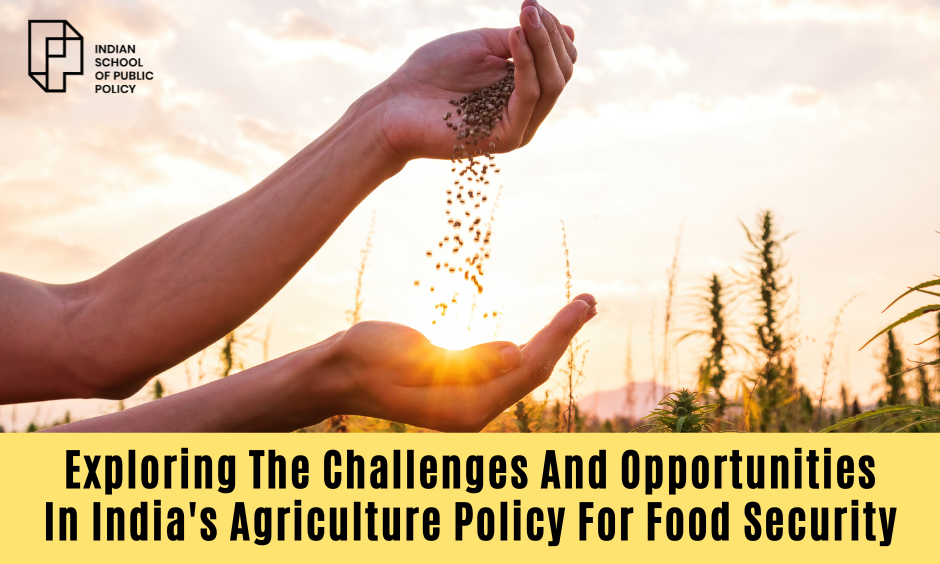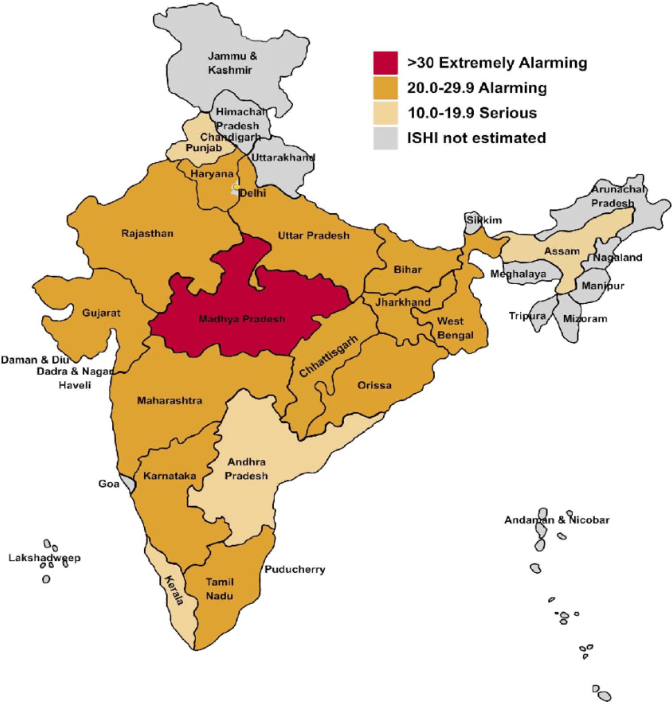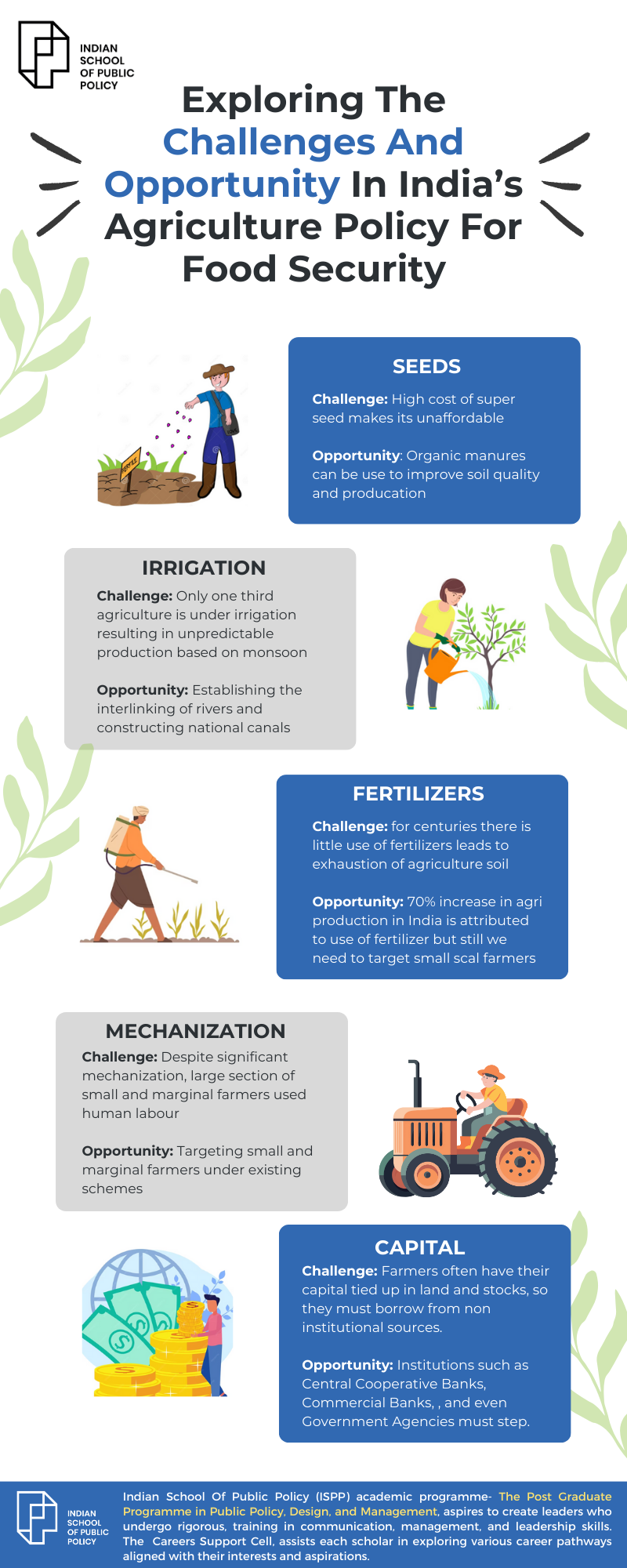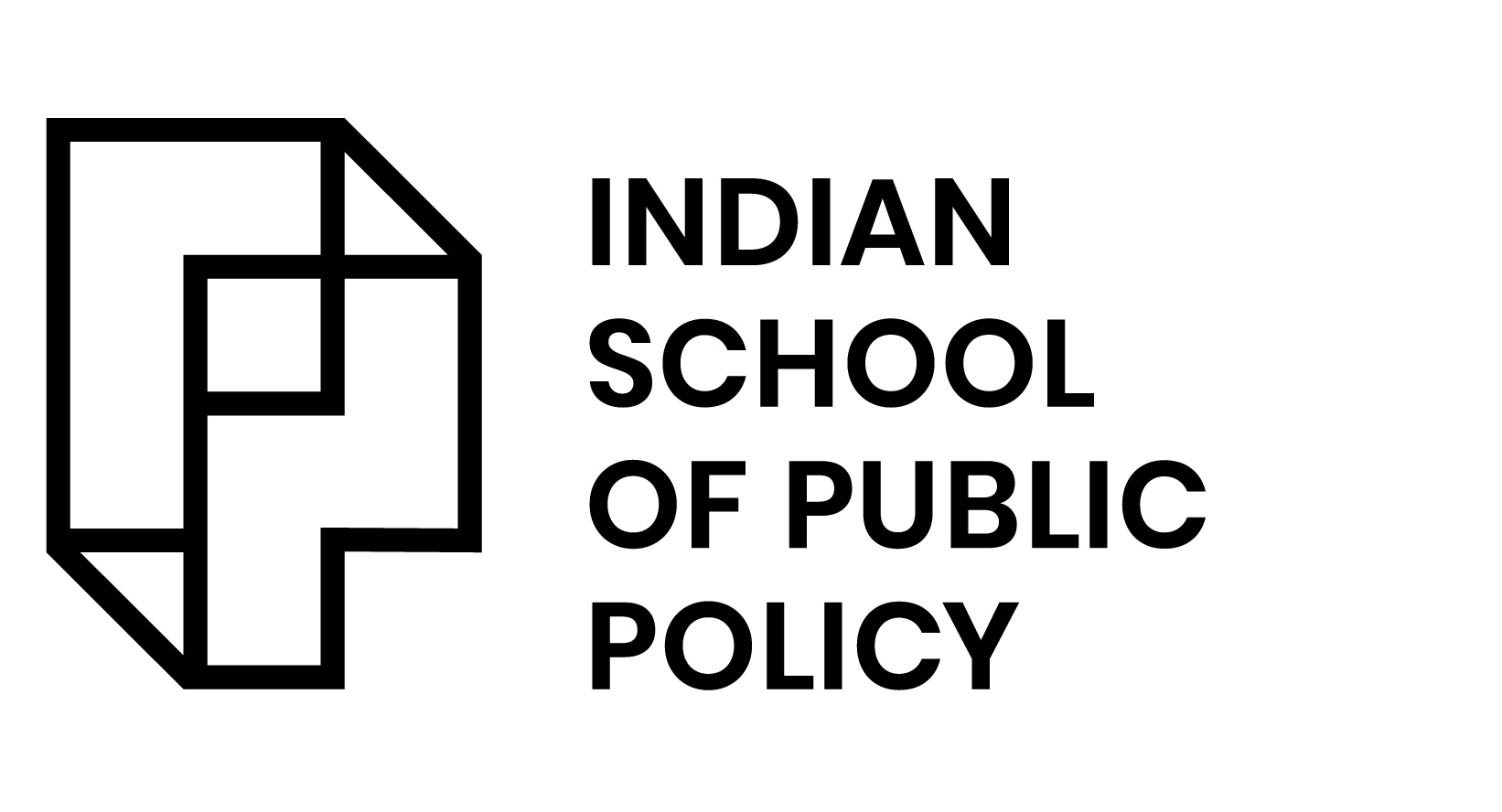
Exploring The Challenges And Opportunities In India’s Agriculture Policy For Food Security

India, once a predominantly agrarian economy, now faces the paradox of being a global food producer while millions remain undernourished. Despite being the second-largest producer of food in the world, India is home to one of the highest numbers of undernourished people, with approximately 194.6 million people facing hunger, according to the State of Food Security and Nutrition in the World 2022 report by the FAO (Food and Agriculture Organization). This stark contrast highlights the critical challenges within India’s agriculture policy that need urgent attention, especially in terms of food security.
Over the past few decades, India’s agricultural sector has undergone a significant transformation. Once contributing approximately 75% to the nation’s GDP, it now accounts for about 18.3% as of 2022-2023. Despite this decline, agriculture remains a critical component of India’s economy and a vital means of livelihood for millions. However, the sector faces multifaceted challenges that necessitate a critical review of the country’s agriculture policy, particularly concerning food security.
Current State of Food Security in India
According to the Global Food Security Index 2022, India has a 16.3% prevalence of undernutrition. Despite being one of the largest food producers globally, millions of citizens still lack access to sufficient, safe, and nutritious food. The paradox of being a global food production leader yet grappling with food insecurity underscores the urgent need for a robust and effective agriculture policy.
Madhya Pradesh, Jharkhand, Bihar, and Chhattisgarh really struggle with food insecurity. They often rank low on the India State Hunger Index (ISHI). Madhya Pradesh is even labeled as ‘extremely alarming.’ These regions face significant challenges in addressing hunger, despite their agricultural potential, due to factors like inadequate infrastructure, poverty, and poor access to nutritious food.

Further, a report published by the National Institution for Transforming India (NITI Aayog) highlights the uneven distribution of food and inefficiencies in supply chains as significant contributors to food insecurity. While government schemes like the Public Distribution System (PDS) aim to address these challenges, their limited reach and inefficiencies often fail to meet the nation’s food security goals comprehensively.
Key Challenges in India’s Agriculture Policy Regarding Food Security
Factors such as poverty, regional disparities, inadequate storage facilities, and post-harvest losses exacerbate the situation of food insecurity in India, leaving millions undernourished despite the country’s agricultural abundance. Such factors need to be kept in mind while planning agriculture policy in India. These are the following challenges in India’s agriculture policy:
1. Seed Quality and Accessibility
High-quality seeds are essential for enhancing crop yields and ensuring consistent agricultural output. However, the high cost of superior seeds makes them unaffordable for many farmers, posing a significant obstacle to productivity.
Additionally, the development of climate-resilient seeds, as highlighted in by AP News, is critical. Climate change has resulted in increased droughts and unpredictable rainfall, making these seeds indispensable. Organizations have started working on genetically modified and hybrid seed varieties to help mitigate such risks, but their accessibility remains a challenge.
2. Irrigation Infrastructure
India is the world’s second-largest irrigated nation after China, yet only about one-third of its cropland is irrigated. This limitation is significant, given the country’s tropical monsoon-dependent agricultural systems. In order to achieve substantial agricultural growth, more than 50% of the cultivated land must be irrigated. Reports from Le Monde emphasize the urgent need for sustainable water management practices.
The Little Ray Of Hope
The agricultural success in Punjab, Haryana, and western Uttar Pradesh is largely due to over half of the cultivated land being irrigated. To boost productivity further, many areas still need irrigation. Interstate cooperation in water management can maximize water resources, while river interlinking and national canals can enhance irrigation systems and support farmers during monsoon failures.
3. Soil Health and Fertilizer Use
Indian soils have been overexploited for centuries, often without replenishing lost nutrients. This has led to significant soil exhaustion, reduced crop yields, and declining fertility levels. Over-reliance on chemical fertilizers has further deteriorated soil health while contributing to environmental contamination.
Potential of Organic Alternatives
Research published in PubMed Central highlights the benefits of organic manures and biofertilizers in rejuvenating soil health sustainably. Despite having the capacity to generate 650 million tonnes of rural compost and 16 million tonnes of urban compost annually, India has yet to fully utilize this resource. Leveraging these organic alternatives could not only reduce the dependence on chemical fertilizers but also address challenges like waste disposal and improve agricultural sustainability.
Role of Chemical Fertilizers
Initially, chemical fertilizers were rarely used in India. However, with heavy government subsidies and a progressive shift in mindset among farmers, their adoption has grown significantly since independence. Biocides and fertilizers have played a vital role in protecting crops and boosting yields. In fact, fertilizers can increase agricultural output by up to 70%. This has been instrumental in improving agricultural prosperity in a country as vast as India.
Challenges of Overuse
While chemical fertilizers and biocides have successfully mitigated crop losses and enhanced productivity, their overuse has led to unintended consequences. Excessive reliance on these inputs has degraded soil quality, disrupted ecological balance, and imposed environmental costs.
4. Mechanization and Technological Adoption
Despite advancements in agricultural technology, large sections of Indian agriculture still rely on manual labour. This low level of mechanization hampers productivity. Government campaigns like ‘Made in India’ and ‘Digital India’, and Agritech innovations, as mentioned in NITI Aayog’s report, can provide farmers with access to modern machinery, efficient supply chains, and real-time data for better decision-making. Government initiatives under the Digital India Mission offer significant potential to transform rural agriculture by connecting farmers with agritech startups.
5. Access to Capital
Farmers often face difficulties accessing capital, with money lenders remaining their primary source of financing. As agricultural technology advances, the need for financial investment becomes increasingly important. Farmers often have their capital tied up in land and stocks, so they must borrow money to enhance agricultural output. Unfortunately, in rural areas, money lenders, traders, and commission agents often serve as the primary sources of funding for farmers, charging exorbitant interest rates and purchasing agricultural products at low prices.
Studies from ResearchGate highlight that cooperative credit agencies and government-backed financial schemes need to be strengthened to offer loans at lower interest rates. These measures will reduce the financial burden on farmers, enabling them to invest in modern farming techniques.
Opportunities for Improvement in Food Security in India
Addressing these challenges presents numerous opportunities to enhance India’s agriculture policy:
1. Promotion of Organic Farming
Transitioning to organic farming can reduce input costs and improve long-term soil health. Initiatives supporting certification processes and organic produce market access can increase small farmers’ profitability.
For instance, Sikkim’s organic transition initiative has made Sikkim India’s first fully organic state. It not only enhanced soil health but also created economic opportunities for farmers through a strong market for organic products.
2. Development of Climate-Resilient Seeds
Expanding research and development in climate-resilient seed varieties can empower farmers to tackle changing weather patterns effectively. Reports from AP News emphasize the importance of providing accessible training alongside these seeds to ensure optimal utilization.
For example, DeHaat, is a successful agritech startup that connects farmers with agricultural services via a digital platform, offering access to information, resources, and markets, improving productivity for small-scale farmers.
3. Digitalization and Agritech Innovations
Integrating AI and IoT in farming can optimize resource utilization and improve productivity. Successful case studies in NITI Aayog’s findings illustrate the benefits of digital tools for small-scale farmers, such as mobile-based advisories and precision farming techniques.
4. Capital Resolution
Despite their monopolistic position, the money lenders remain the sole providers of agricultural loans. However, there is a pressing need to transform the rural finance landscape. Institutions such as Central Cooperative Banks, State Cooperative Banks, Commercial Banks, Cooperative Credit Agencies, and even Government Agencies must step in to offer farmers loans with favourable terms. This significant change will empower farmers and help them access financing options that better serve the needs of small low-income farmers.

The Dire Need for Skilled Policymakers in Contributing Towards Food Security
As India navigates the evolving dynamics of its agriculture sector, it becomes evident that skilled policymakers are essential for designing and implementing impactful solutions. Public policies need to address systemic inefficiencies while promoting inclusivity and sustainability.
Where Can Policymakers/Policy Aspirants Gain Expertise to Ensure Food Security?
The Indian School of Public Policy (ISPP) offers a flagship program, the Post Graduate Programme in Public Policy, Design, and Management, designed for those passionate about influencing public policy. This one-year program provides:
- Comprehensive Curriculum: The programme includes seven terms covering policy analysis, economics, governance, and specialized topics such as agriculture policy.
- Capstone Exercise: Students undertake hands-on projects addressing real-world challenges, including food security and agricultural reforms.
- Networking Opportunities: Participants collaborate with industry experts, policymakers, and academicians through workshops, guest lectures, and interactive sessions.
Programme Highlights
- HARRIS UCHICAGO Certificate in Public Policy: It provides students with global exposure to contemporary challenges.
- Immersive Learning Projects: ISPP offers practical experience in tackling live policy issues.
- Interactive Labs: Students are trained in analytical and creative problem-solving exercises.
- Career Support & Placements: ISPP provides focused career guidance to prepare students for leadership roles.
Learn more about the transformative curriculum and opportunities at ISPP here.
Student Testimonials


Conclusion
India stands at a crossroads in its agricultural journey. With a growing population, evolving climate challenges, and an urgent need to ensure food security, innovative policies and practices are non-negotiable. By empowering skilled policymakers and fostering collaboration between stakeholders, India can address its agriculture sector’s challenges and unlock its full potential.
To learn more about how you can contribute to policy development in agriculture and food security, explore the Indian School of Public Policy’s transformative Post Graduate Programme in Public Policy and take the first step towards becoming a leader in shaping India’s future.
FAQs
What is the current status of India’s agriculture policy for food security?
India’s policy faces challenges like low productivity, water scarcity, and inadequate infrastructure. While progress has been made, significant gaps remain.
How can India address the challenges in its agriculture policy?
Promoting sustainable farming, improving irrigation systems, enhancing rural credit, and adopting advanced technologies can help overcome these challenges.
What opportunities exist in India’s agriculture policy for food security?
Expanding organic farming, developing resilient seeds, and leveraging digital innovations offer promising opportunities.
How can India balance food security with environmental sustainability?
Policies promoting eco-friendly practices, reduced chemical dependency, and renewable energy investments are crucial.
What role can government policies play in addressing food security challenges?
Government policies must facilitate subsidies, access to technology, and frameworks for climate adaptation and resource distribution.
Reference links
- https://apnews.com/article/climate-change-resilient-seeds-agriculture-india-drought-rains-587cf822c3000072584ba58562d2a321
- https://pmc.ncbi.nlm.nih.gov/articles/PMC3481742/
- https://pmc.ncbi.nlm.nih.gov/articles/PMC8815769/
- https://pmc.ncbi.nlm.nih.gov/articles/PMC9808200/
- https://pmc.ncbi.nlm.nih.gov/articles/PMC10264273/
- https://pmc.ncbi.nlm.nih.gov/articles/PMC9356645/
- https://pmc.ncbi.nlm.nih.gov/articles/PMC9736663/
- https://www.niti.gov.in/sites/default/files/2023-04/Report-UNCDF.pdf
- https://www.lemonde.fr/en/environment/article/2024/09/05/central-india-s-green-cotton-gently-weaves-its-web_6724956_114.html
- https://www.researchgate.net/publication/366787737_Food_System_in_India_Challenges_Performance_and_Promise
- https://www.jstor.org/stable/24092097


